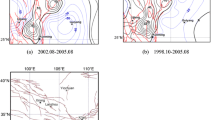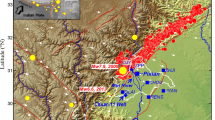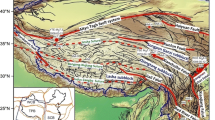Abstract
Although it is well known that coseismic gravity changes take place during an earthquake, previous research has not yielded convincing evidence demonstrating that significant gravity changes occur before large earthquakes. Furthermore, even if we suspect that gravity changes occur before large earthquakes, we have yet to demonstrate how to consistently observe these changes for useful earthquake forecast that would bring benefits to society. We analyzed ground gravity survey data obtained in 1998, 2000, 2002, and 2005 at stations of the Crustal Movement Observation Network of China (CMONOC) and examined gravity changes before the occurrence of nine large (M s ⩾6.8) earthquakes that ruptured within or near mainland China and Taiwan from November 2001 to August 2008. Results from this analysis show that significant gravity changes occurred across a large region before each of these nine large earthquakes, and these changes were detected by repeated ground gravity surveys through CMONOC. Although these gravity changes were significant, more research is needed to investigate whether these gravity changes could be viewed as precursors of large earthquakes. Limitations and uncertainties in the data include sparseness of the gravity monitoring network, long time intervals between consecutive gravity surveys, inevitable measurement errors, hydrological effects on gravity, and effects of vertical crustal movements on gravity. Based on these observations, we make several recommendations about possible future directions in earthquake-related research using gravity monitoring data.
Similar content being viewed by others
References
Keilisborok V I, Knopoff L, Rotvain I M (1980) Bursts of aftershocks, long-term precursors of strong earthquakes [J]. Nature, 283: 259–263
Wyss M, Slater L, Burford R O (1990) Decrease in deformation rate as a possible precursor to the next Parkfield earthquake [J]. Nature, 345: 428–431
Ihmle P F, Jordan T H (1994) Teleseismic search for slow precursors to large earthquakes [J]. Science, 266: 1547–1551
Swinbanks D (1994) Earthquake forecasters face their critics in Japan [J]. Nature, 370: 9
Geller R J (1997) Earthquake prediction: a critical review [J]. Geophysical Journal International, 131: 425–450
Geller R J, Jackson D D, Kagan Y Y, et al. (1997) Earthquakes cannot be predicted [J]. Science, 275: 1616–1617
Wyss M, Booth D C (1997) The IASPEI procedure for the evaluation of earthquake precursors [J]. Geophysical Journal International, 131: 423–424
Oliver H W, Kane M F, Pakiser L C (1961) Gravity anomalies in central Sierra Nevada, California [J]. Journal of Geophysical Research, 66: 4265–4271
Barnes D F (1966) Gravity variations during Alaska earthquake [J]. Journal of Geophysical Research, 71: 451–456
Page R (1968) Aftershocks and microaftershocks of great Alaska earthquake of 1964 [J]. Bulletin of the Seismological Society of America, 58: 1131–1168
Imanishi Y, Sato T, Higashi T, et al. (2004) A network of superconducting gravimeters detects submicrogal coseismic gravity variations [J]. Science, 306: 476–478
Sun W K, Okubo S (2004) Coseismic deformations detectable by satellite gravity missions: A case study of Alaska (1964, 2002) and Hokkaido (2003) earthquakes in the spectral domain [J]. Journal of Geophysical Research Solid Earth, 109: B04405
Han S, Shum C K, Bevis M, et al. (2006) Crustal dilatation observed by GRACE after the 2004 Sumatra-Andaman earthquake [J]. Science, 313: 658–662
Chen Y T, Gu H D, Lu Z X (1979) Variations of gravity before and after the Haicheng earthquake, 1975, and the Tangshan earthquake, 1976 [J]. Physics of the Earth and Planet Interiors, 18: 330–338
Wei M H, Zhao W, Ma L (1985) Gravity variations before and after the Tangshan earthquake of July 28, 1976, and possible interpretation [J]. Journal of Geophysical Research-Solid Earth and Planets, 90: 5421–5428
Gu G X, Kuo J T, Liu K R, et al.(1998) Seismogenesis and occurrence of earthquakes as observed by temporally continuous gravity variations in China [J]. Chinese Science Bulletin, 43: 8–21
Kuo J T, Zheng J H, Song S H, et al. (1999) Determination of earthquake epicentroids by inversion of gravity variation data in the BTTZ region, China [J]. Tectonophysics, 312: 267–281
Liu K R, Zheng J X, Kuo J T, et al. (2002) Mobile gravity survey and the combined dilatation model (CDM) in the BTTZ region (in Chinese) [M]//Advances in Pure and Applied Geophysics. Beijing: Meteorological Publishing House
Xu H (2003) Function of gravimetry in CMONOC [J]. Journal of Geodesy and Geodynamics, 23: 1–3 (in Chinese)
Zhang W M, Wang Y, Zhou X H (2008) Expectation and application study of absolute gravity observation technology in China [J]. Progress in Geophysics, 23: 69–72 (in Chinese)
Zhu Y, Zhan F B, Zhou J C, et al. (2010) Gravity measurements and their variations before the 2008 Wenchuan earthquake [J]. Bulletin of the Seismological Society of America, 100: 2815–282
Fan Y, Van den Dool H (2004) Climate Prediction Center global monthly soil moisture data set at 0.5 degrees resolution for 1948 to present [J]. Journal of Geophysical Research-Atmospheres, 109: D10102
Döll P, Kaspar F, Lehner B (2003) A global hydrological model for deriving water availability indicators: model tuning and validation [J]. Journal of Hydrology, 270: 105–134
Rodell M, Houser P R, Jambor U, et al. (2004) The global land data assimilation system [J]. Bulletin of the American Meteorological Society, 85: 381–394
Milly P C D, Shmakin A B (2002) Global modeling of land water and energy balances. Part I: the land dynamics (LaD) model [J]. Journal of Hydrometeorology, 3: 283–299
Zhou J C, Sun H P, Xu J Q (2009) Validating global hydrological models by ground and space gravimetry [J]. Chinese Science Bulletin, 54:1534–1542
Zhou J C, Zhan F B, Zhu Y (2010) Hydrological effects on the results of regional gravity survey in China. (manuscript under revision)
Zhu Y, Liang W, Xu Y, et al. (2006) Spatial-temporal characteristics of gravity field dynamics in mainland China and forecast of earthquake trends (in Chinese) [C]. Annual Research Report about Earthquake Trends in China in 2007, Second Crust Monitoring and Application Center, China Earthquake Administration, Xi’An, China
Zhu Y, Liang W, Xu Y (2008) Medium-term prediction of M s8.0 earthquake in Wenchuan, Sichuan by mobile gravity [J]. Recent Developments in World Seismology, 7: 36–39 (in Chinese)
Zhu Y, Hu B, Li H, Chen B (2003) Variation of gravity field of Xinjiang area and Jiashi Ms6.8 earthquake [J]. Journal of Geodesy and Geodynamics, 23(3): 66–69 (in Chinese)
Zhu Y, Xu Y, Liang W (2008) Medium-term prediction of Yutian, Xinjiang M s7.3 earthquake in 2008 [J]. Journal of Geodesy and Geodynamics, 28(5): 66–69 (in Chinese)
Author information
Authors and Affiliations
Corresponding author
Additional information
Supported by the Chang Jiang Scholar Awards Program of China; the National Science Foundation of China (No. 40874035); the Special Earthquake Research Project from China Earthquake Administration (No. 200908029); the Knowledge Innovation Initiative of the Chinese Academy of Sciences (No. KZCX2-YW-133); the National Natural Science Foundation of China (No. 40730316).
ZHAN F. Benjamin is professor of Geographic Information Science and director of the Texas Center for Geographic Information Science in the Department of Geography at Texas State University-San Marcos. He also holds a Chang Jiang Scholar Guest Chair Professorship at Wuhan University in China. His major research interests are in Geographic Information Science as well as its applications, including (1) (visual) spatial analysis and modeling, (2) health and the environment, (3) hazards research and risk analysis, and (4) transportation and network science.
About this article
Cite this article
Zhan, F.B., Zhu, Y., Ning, J. et al. Gravity changes before large earthquakes in China: 1998–2005. Geo-spat. Inf. Sci. 14, 1–9 (2011). https://doi.org/10.1007/s11806-011-0440-0
Received:
Published:
Issue Date:
DOI: https://doi.org/10.1007/s11806-011-0440-0




